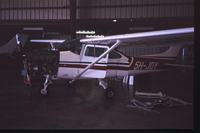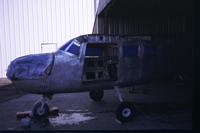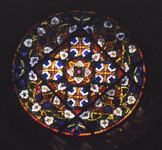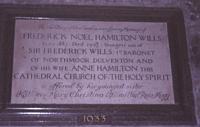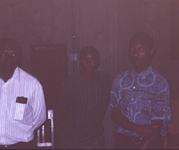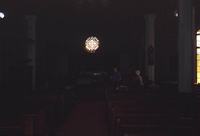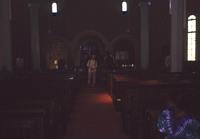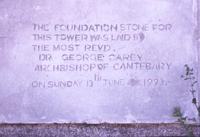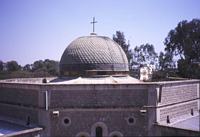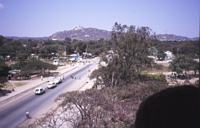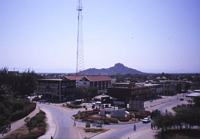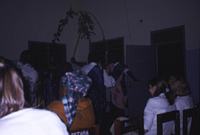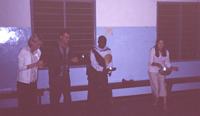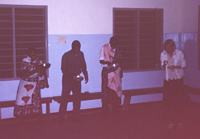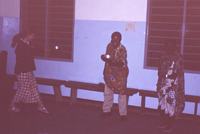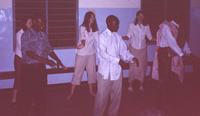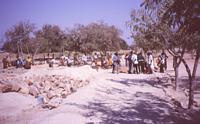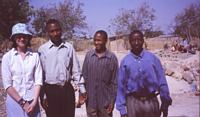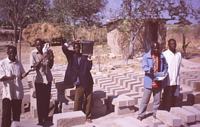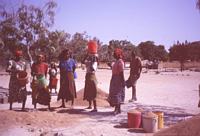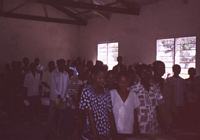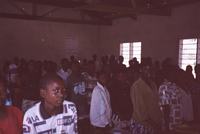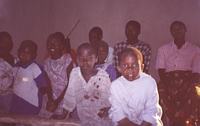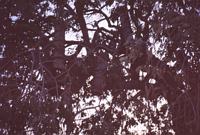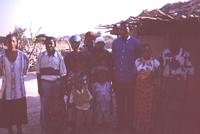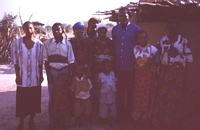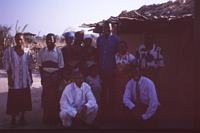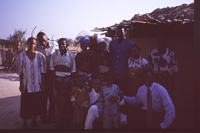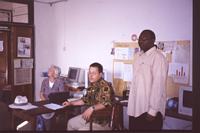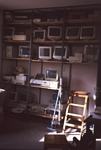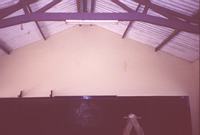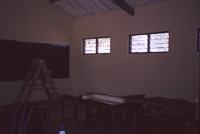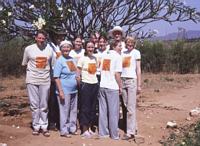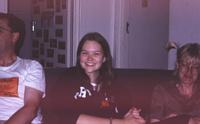Thurs 11 July
Thursday was spent visiting Dodoma. The Missionary Aviation Fellowship (MAF) supports missionary transportation around inaccessible parts of Africa. They have a complete maintenance section, a proper western style engineering set up. Its really like walking out of Africa and back into Europe, except for the heat. MAF are likely to close the Dodoma facility, as it no longer serves their aims - this part of Africa is now quite accessible!
This plane has been completely stripped back to its chasis and is being inspected for metal fatigue. They really do do everything. MAF have a hanger at Dodoma airport. There is only one runway, but its big enough for small comercial jet traffic, if required.
Dodoma Cathederal
John and I had visited the cathedral
before, but now was the official visit. Once again we met
the reverend George, the dean of the cathedral, a tall, slim, man
with a genial, friendly approach, who just couldn't do enough for
us. Today he acted as our guide, provided us with drinks (sodas
as always), and talked about his cathedral and what he is trying
to do.
A plaque remembering the founder of the cathedral. Who apparently has connections with Chelmsford.
Without the instruction book, I had no idea how to set the camera up for these indoor shots. This is a the stain glass window from a distance.
This is Liz in the cathedral.
Like Basildon, Dodoma cathedral also has a controversial bell tower, the foundation stone was laid by our retiring Archbishop - George Carey. The tower is not yet finished, and they are hoping to get some work complete by the time the 3/4 centenary celebrations occur at the end of October. The real need in the church is more space for worship. The tower is only there to compete with the Catholics, who have a larger church with a built in tower.
However it does
provide some nice views, even if you do have to climb over the rubbish
on the stairs to get to the top. I'm grateful that it is there,
the next few pictures give a good impression of Dodoma.
The top of the cathedral from
the tower.
Here the roads are tarmac, although there are no pavements, and there is the ever present sandy soil. the cars in the picture are most likely taxis. The taxis are very nice, and resonably cheap. Remember that Dodoma is the capital city.
International
Night
The students
oransied a fun evening for our last night together. Some of
our party also performed or ran games, all of us joined in. Great
fun was had by all. Here is a pancake flipping contest that
proved to be very popular with the Africans.
Julie, John,
? , Mandy
More flipping....
?, ?, Frederick, and Julie
doing the timing.
Still more flipping....
Carrie, ?, ?
The dance
- Tragedy
The
girls in our party taught the students the Steps dance to Tragedy.
They had worked really hard to learn it, an performed very
well.
ER? Another camera glitch
Students and all, I'll add the names that I know, if I can improve the picture. This is the last time we were all together. The next day we would be packed up and be making our way to the villages.
Fri 12 July to Sun 14 July - In Chibelela
On Thursday night we packed our things and prepared to take another step into the unknown. We had seen huts like this in the villages we had visited, but we didn't really know what it was like, or what it was going to be like. We didn't know the hosts we were going to stay with, only their sons or daughters. We didn't know how to behave as guests, what was expected of us socially, or any of the customs that we were going to have to live up to. We did know that the college we had been living in had luxuries that the villagers would only dream about - electricity, running clean water. One of the greatest worries was the toilets. Our current accommodation had reasonably good toilet facilities. The villages have 'long drops'. That is a pit, covered by stones (almost), and surrounded by a four foot wall. You have to take care of your personal belongings, or they will fall out of your pockets, and then you'll find the answer to "How much does a wallet have to contain before you retrieve it from a long drop?"
School building in Chibelela
Ruck sacks
packed we and our student friends (different ones this time) loaded
up into the land rovers for a journey to Dodoma, where we would
pick up the dalla dalla. Jason would be taking us to his village.
We arrived in Dodoma, and unloaded, and trekked through the
town to the various bus stations (large laybys, or just the side
of the road. These dalla dalla's reminded me of 2nd world
war style busses although they are brightly painted. They
are high up, with plenty of storage spaces under the seats, and
a roof rack, that much more than doubled it, and are surrounded
by things people want to take with them. We left our ruck
sacks and went to get lunch. We found quite a nice restaurant
that provided 'fast food' - rice and stew. On returning late
we waited for quite some time because they were still loading the
bus. During this time we met one of Jasons friends, who insisted
on buying us Sodas (Coke, Fanta, etc). There is a deposit
on the bottles, and when it was time to board we had not finished,
so he had to give up his deposit. We fought our way on the
bus, it was already full, all the seats taken, and apparently all
the standing room as well. Jason, located our seats, which
were pre-booked, and chucked the people out, so that the wazungu
could sit down. We took up our seats, Liz by the window, me
next to her, with a little old lady on the end (3-seats on the right,
two on the left).
The little old lady had stuffed two big bags
of something under the seat in front, and in our foot space, so
it was hard to move. We waited a while, as more people got
on, and the loading was completed, and then we moved off. To get the full story click here
Liz Johanna, Jason, and Jasons cousin 'Lister'. That was the nearest name they could find to anglisise his real name. On Saturday morning we went for a 'guided tour' of the village, to the doctors surgery, the shopping area, and to the school. The school is being extended. We asked permission to take pictures and it was granted.
Brick Making
Here are the men
making bricks. The bricks are made from the soil mixed with
water and allowed to dry.
The women collect the water, there was a long trail of them in the distance at one point, all with buckets on their heads (How do they do that, its such a useful skill all children should learn it!).
These are the children from the top year of the school, they are cramming for their final exams. These children are generally 11/12/13 year olds. They are in the classroom unsupervised. When we went in their study was interrupted, they all stood up and said in English "Education is the key to life".
They were keen to have their picture taken, so I had to make sure I'd got everyone in.
These are Tanzanian bee hives. We spotted these on the way back to the house. After the incident with the plant, I was careful to ask if I could approach them before I took a picture. Honey is cultivated for its medicinal qualities, and is a scarce resource. They DO NOT use it to sweeten the Chai (tea).
We had been walking around the village talking about the things we saw, and came across one of the 'hedges' that were used to mark the side of the road. Its a spindly plant with long green seed pods, and we were told that it had many uses, including making glue. I picked one of the pods and broke it in half, a white milky fluid slowly dribbled out of the pod. It was not at all sticky, as I had expected.
The next four pictures were taken hurriedly as the Land rover arrived to take us back to Msalato. they show the wider family that lived in the houses in which we stayed.
We did finally find Justin, and get him in the picture.
DCT Computers
This is Martins day job. Martin
and his assistant provide computer services to the diocese. They
mostly use Windows 95 or 98, and are short of almost everything.
In the picture is
DCT Computers
Some of the spares, and things
to be fixed. Lots of screens, but screens are the things that
prove least reliable when they're moved around a lot.
Painting the Classrooms
Wed 10 July, Monday 15 July
This is a picture of one end of the school room that we painted. These pictures were taken out of sequence, after the painting was finished. We had taken the brushes and rollers with us, but the paint was purchased locally. Its nothing like the paint you buy here. This is ammonia based, and is VERY thin. To get good cover on the walls we needed four coats. We also painted the wood work, and the gloss is similar to the gloss paint here. The gloss dries very quickly because of the dry heat.
The windows in the school room are louvres. There is no need to retain heat - its never cold. The louvres are in a poor state of repair and are covered on the outside with wire mesh to keep the mosquitoes out. In this picture you can see the 'ladder'. This we used along with a roller on a stick to help us get to the highest points.
In the Groth's House
In the Groth's garden, saying goodbye
Julie 'under attack' from Mandy
Mandy
